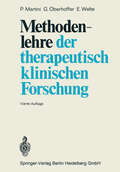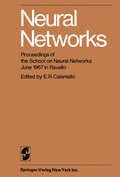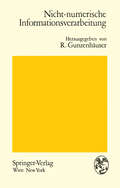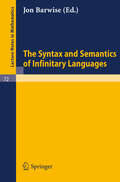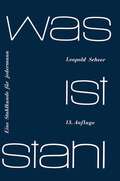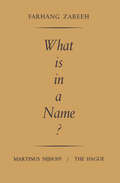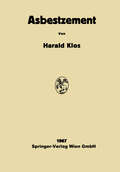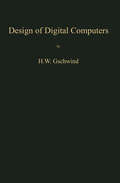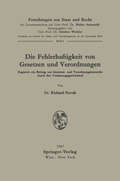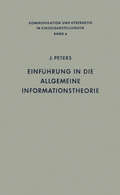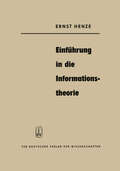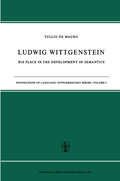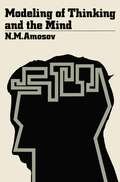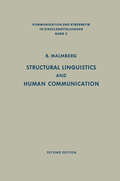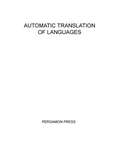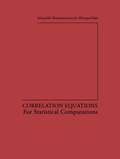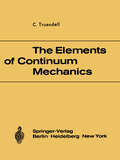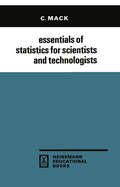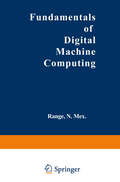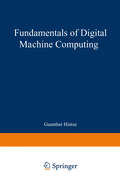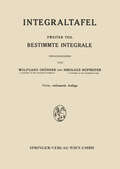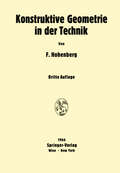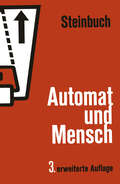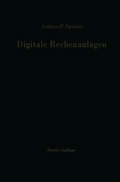- Table View
- List View
The European Computer Users Handbook 1968/69: Pergamon Computer Data Series
by Sam StuartThe European Computer Users Handbook 1968/69, Sixth Edition is a handbook of computers and computer peripherals which could be used in Europe. Details of computers and peripheral devices, including analog computers, calculators, and data transmission equipment, are presented. This book is organized into 10 sections and begins by giving information on digital computers that could be used in Europe based on recommendations by Computer Consultants Limited. Comments on the particular computer manufacturer concerned are included and the particular item of equipment is described. Digital computers, electronic calculators, analog computers, peripheral equipment, and data transmission equipment available in Europe are then listed. The names and addresses of computer manufacturers and selling organizations concerned with computers used in Europe are also provided. Two tables are given: one for computer installations by number, import value, and home built value in sixteen European countries, and another for computer installations in the United States. This monograph will be a valuable resource for both computer users and manufacturers.
Neural Networks: Proceedings of the School on Neural Networks June 1967 in Ravello
by E. R. CaianielloSciences may be nowadays grouped into three classes, having as their subjects of study respectively Matter, Life and Intelligence. That "Intelligence" may be studied in a quantitative manner is a discovery of our age, not less significant in many ways than the 17th ceiltury realization that celestial phenomena are of one and the same nature as terrestrial and all other physical accidents. As the latter was accomplished through and accompanied by a major revolution in philosophy and method, so is now the scientific investigation of intelligent phenomena - although harely begun - already causing an unprecedented revolution in all our previous conceptions as mind and machine, society and organization. What electronic com puters have already accomplished in disclosing perspectives to sciences and imposing new approached to management is but a negligible change, if compared to those yet in store, which will closely follow the understanding of the many as yet unknown functional principles which make nervous systems act and react the way they do. The study of Neural Networks is the key point in the systematic quantitative investigation of such phenomena. With patience and humility, neuroanatomists and physiologists try to connect structure with function in systems of neurons which are "simple" enough to be studied with the extant techniques, either because of the paucity of their elements or because of the high degree of symmetry these possess (e. g.
Nicht-numerische Informationsverarbeitung: Beiträge zur Behandlung nicht-numerischer Probleme mit Hilfe von Digitalrechenanlagen
by R. GunzenhäuserDie nicht-numerische Informationsverarbeitung mit Hilfe von Rechen automaten begann in den frühen fünfziger Jahren. 1950 befaßte sich SHANNON mit Schachprogrammen, 1952 schrieb RUTISHAUSER seine bahnbrechende Arbeit über automatische Rechenplanfertigung und begründete damit die Entwicklung der formalen Sprachen. Etwa um die gleiche Zeit veröffentlichte D. H. LEHMER, angeregt durch die Bedürfnisse der Kernphysiker, die bis jetzt gebräuchlichste Methode zur Erzeugung von Zufallszahlen auf Rechenautomaten. Damit standen Zufallszahlen auch für nicht-numerische Anwendungen zur Verfügung. 1953 wurde die Sprache FORTRAN publiziert, 1960 die Sprache ALGOL. Im gleichen Jahr ließ H. WANG 220 Sätze aus den Principia mathematica in 3 Minuten von einem Rechenautomaten beweisen, 196:3 entstanden die ersten Computographien von }( NAKE. Die Anregung, das rasch wachsende Gebiet in einer deutschen Buchveröffent lichung darzustellen, geht auf Herrn Direktor Dr. W. SCHWABL vom Springer Verlag Wien zurück. Bald zeigte sich hierbei, daß ein einzelner Autor nicht imstande sein würde, das Gebiet in seiner ganzen Vielfalt darzustellen, und zwar selbst dann nicht, wenn die rein kommerzielle nicht-numerische Datenverarbeitung ausgeklammert würde. Damit entstand der Gedanke, eine Arbeitsgemeinschaft von Autoren ins Leben zu rufen, die jeweils eine zusammenfassende Darstellung über ihr eigenes Arbeitsgebiet geben sollten.
Asbestzement: Technologie und Projektierung
by Harald KlosIn Gesprächen mit Asbestzement-Erzeugern, Betriebsleitern, Betriebs leuten und Technologen sowie mit auf diesem Gebiet tätigen Maschinen bauern, Projektanten, Konstrukteuren und für die Inbetriebsetzung ver antwortlichen Technikern konnte ich immer wieder feststellen, wie sehr das Fehlen ausreichender Literatur über Asbestzement als Mangel empfunden wird. Dabei konnte ich zusätzlich feststellen, daß selbst die vorhandene Asbestzement-Literatur viel zuwenig bekannt ist. Daraus resultierte mein Entschluß, manohes, was in der Literatur aufzufinden war, sowie einiges von den Erfahrungen, die ich als projektierender und konstruierender Ingenieur bei der Inbetriebsetzung mehrerer Anlagen und in Gesprächen mit Kunden und Interessenten gesammelt hatte, systematisch zu ordnen und in Form des vorliegenden Buches einem größeren Kreise zugänglich zu machen. Das Buch wendet sich in erster Linie an den praktisch tätigen Ingenieur. Von diesem Gesichtspunkt aus habe ich jene Abschnitte kürzer gehalten, die für den Praktiker von geringerer Bedeutung sind, und habe bewußt auf die Behandlung allzu spezieller Probleme verzichtet. Die Asbesttechnologie enthält noch viele Fragen, die nicht restlos geklärt sind. Meine Darstellung, die sich weitgehend auf eigene Erfahrungen stützt, ist daher an manchen Stellen notwendigerweise subjektiv. Ich hoffe jedoch, daß dies kein Mangel ist.
Die Fehlerhaftigkeit von Gesetzen und Verordnungen: Zugleich ein Beitrag zur Gesetzes- und Verordnungskontrolle durch den Verfassungsgerichtshof (Forschungen aus Staat und Recht #5)
by Richard NovakDie »Forschungen aus Staat und Recht" sind WALTER ANTONIOLLI gewidmet. Er hat als Forscher und Lehrer den eigentlichen AnstoB zu einer Erneuerung des Denkens auf den Gebieten des offentlichen Rechts und der Staatslehre in Osterreich gegeben. Schuler und Freunde haben es ihm zu danken, daB er ihnen den Weg zu methodischen Auffassun gen gewiesen hat, die aus dem engen Formalismus herausfiihren. Dar aus erkHirt es sich, daB die Forschungsreihe unverkennbar von methodi schen Anliegen gepdigt ist. Diese zeigen sich auch in jenen Untersuchun gen, die spezielle Themen zum Gegenstand haben. Die vorliegenden und die geplanten Abhandlungen verbindet das Bestreben zu einer Einheit, mit allen Mitteln der Erkenntnis zur Erforschung von Staat und Recht in wissenschaftlich-selbstkritischer Weise beizutragen. Darin liegt gleichzeitig eine offene Absage an ein ideologisierendes Rechtsden ken einerseits und an eine verengte formalisierende Methode anderer seits. In diesem Sinn ist die Forschungsreihe nicht nur als ein Zeichen offentlichen Dankes an WALTER ANTONIOLLI, sondern auch als ein wissenschaftliches Bekenntnis gedacht. Seit Jahren liegt die Veroffentlichung von Monographien auf den Gebieten des offentlichen Rechts und der Staatslehre im argen. Die durch das vorgegebene Absatzgebiet gebotene Beschrankung jeder Auf lage machte ihre Herstellung ohne fremde Mittel geradezu unmoglich. Private und offentliche Stellen zeigten sich dieser Notlage gegenuber aufgeschlossen und unterstutzten durch groBzugige Forderung dieses fiir die wissenschaftliche Diskussion wie fur die Praxis gleicherma6en wichtige Vorhaben. Ihnen sei an dieser Stelle aufrichtig gedankt.
Einführung in die allgemeine Informationstheorie (Communication and Cybernetics #6)
by Johannes PetersLudwig Wittgenstein: His Place in the Development of Semantics (Foundations of Language Supplementary Series #3)
by T. De MauroVarious students of general linguistics and semantics quote and discuss Wittgenstein, among others, OGDEN and RICHARDS (1960), ULLMANN (1951, 1962), PAGLIARO (1952, 1957), WELLS (1960), REGNELL (1960) and 1 ZIFF (1960). For the most part however they quote the Tractatus and not 2 the Philosophical Investigations ; not all of them consider the most important ideas in the Tractatus but often discuss marginal points; above all they often make the discussion of Wittgenstein's ideas secondary to the development of their own thought. It should be added, moreover, that these students are exceptions. The large majority of language theorists, especially those with a philological background, have almost no know ledge of Wittgenstein's ideas. One scholar thinks that Wittgenstein's linguistic philosophy rests upon a grotesque misunderstanding of the workings of language (HERDAN, 1962, Chapter 24). The present book seeks to draw the attention of students of general linguistics and semantics to the thought of both the early and the later Wittgenstein: not only the Philosophical Investigations but also the Tractatus is concerned with everyday language: Wittgenstein was thinking of the propositions of everyday language, when he affirmed that the proposition is a picture of reality (Chapter 1). This conception is very old, it is in fact found in Aristotle and it dominated ancient, mediaeval and modern rationalistic thought; only Locke, Vico and Leibniz criticized it strongly (Chapter 2).
Structural Linguistics and Human Communication: An Introduction into the Mechanism of Language and the Methodology of Linguistics (Communication and Cybernetics #2)
by Bertil MalmbergThe point of departure of this general survey of modern structural linguistics is the place of language in human relations. Linguistics will consequently be understood as a science of communication. My book is not intended as an elementary handbook. The readers are supposed to be in the first place advanced students of linguistics and phonetics and of neighbouring fields where a real awareness of linguistic methods and problems is essential (such as psychology, phoniatrics, speech therapy, language teaching, communication engineering). The book may, however, be of some value also for the general reader who is interested in language, in language learning, or in communication processes. It might finally serve as an introduction to structural theories and practice for those linguists of traditional orientation who would like to make contact with the new trends in the study of language. It is self-evident that, under such circumstances, any reader will find certain chapters in this book rather complicated, others irritatingly elementary. This is, however, unavoidable in a work whose aim is to cover a vast field of knowledge and to offer the reader a synthesis of what appears at first sight to be widely disparate facts and phenomena. Many of the facts brought together here may, regarded superficially, seem to have few or no mutual connections. They can, nevertheless, be combined into a wide humanistic and scientific unity within which numerous lines of relationship bind together physical and psychic, individual and social phenomena.
Automatic Translation of Languages: Papers Presented at NATO Summer School Held in Venice, July 1962
by Aldo GhizzettiAutomatic Translation of Languages is a collection of papers that discusses the various concerns in automatic language translation systems. The text first covers algebraic linguistics and machine translation, and then proceeds to tackling the main concepts in automatic translation of languages. Next, the selection deals with the equivalence of models of language used in the fields of mechanical translation and information retrieval. The text also discusses computational procedure in linguistic research. The next chapters detail syntax and syntactic integration. The book will be of great use to scientists and professionals who involved in the research and development of computerized language translation systems.
Correlation Equations: For Statistical Computations
by Aristarkh K. Mitropol skiiThis book presents methods for computing correlation equations. All the topics treated hefe are eluci dated in terms of concrete examples, which have been chosen, for the most part, from the Held of analysis of the mechanical properties of steel, wood, and other materials. A necessary prerequisite for any study of correlation equations is so me knowledge of the moments of random variables. In the Appendix, there is provided a brief treatment of moments, as well as a discussion of the simplest methods of computing them. We have paid particular attention in this book to the techniques of computing correlation equations, and to the use of tables for alleviating the computationalload. The mathematical bases of the methods used in setting up correlation equations are expounded in the books cited at the end of this volume. A. M. December 1965 PIe ase note that the abbreviation 19 is used in this book to designate the logarithm to base ten, Note further that the comma has been retained as the decimal point in tabular material.
The Elements of Continuum Mechanics: Lectures given in August - September 1965 for the Department of Mechanical and Aerospace Engineering Syracuse University Syracuse, New York
by C. TruesdellThe lectures here reported were first delivered in August and September, 1965, for the Department of Mechanical and Aerospace Engi neering at syracuse University, New York under the sponsorship of the New York State Science and Technology Foundation. Lectures 1-6 and 22-23 are revised from a version prepared by Professor Kin N. Tong on the basis of a transcription of the lectures, kindly provided by Professor S. Eskinazi. The remainder of th~ text has been written out afresh from my own notes. Much of the same ground was covered in my lectures to the Austra lian Mathematical Society's Summer Research Institute at Melbourne in January and February, 1966, and for the parts affected the text conforms to this latter presentation. I am grateful to Professors C.-C. Wang and K. N. Tong for criticism of the manuscript. These lectures constitute a course, not a treatise. Names are attached to theorems justly, to the best of my knowledge, but are not intended to replace a history of the subject or references to the sources.
Essentials of Statistics for Scientists and Technologists
by C. MackStatistics is of ever-increasing importance in Science and Technology and this book presents the essentials of the subject in a form suitable either as the basis of a course of lectures or to be read and/or used on its own. It assumes very little in the way of mathematical knowledge-just the ability to substitute numerically in a few simple formulae. However, some mathematical proofs are outlined or given in full to illustrate the derivation of the subject; these can be omitted without loss of understanding. The book does aim at making clear the scope and nature of those essential tests and methods that a scientist or technologist is likely to need; to this end each chapter has been divided into sections with their own subheadings and some effort has been made to make the text unambiguous (if any reader finds a misleading point anywhere I hope he will write to me about it). Also with this aim in view, the equality of probability to proportion of population is stated early, then the normal distribution and the taking of samples is discussed. This occupies the first five chapters. With the principles of these chapters understood, the student can immediately learn the significance tests of Chapter 6 and, if he needs it, the analysis of variance of Chapter 7. For some scientists this will be most of what they need. However, they will be in a position to read and/or use the remaining chapters without undue difficulty.
Integraltafel: Zweiter Teil Bestimmte Integrale
by Wolfgang Gröbner Nikolaus HofreiterDer zweite Teil der Integraltafel, welcher die bestimmten Integrale umfaßt, gleicht in seinem Aufbau dem ersten Teil. Er enthält vor allem solche Integrale, die im ersten Teil nicht vorkommen, weil die betreffenden Integralfunktionen nicht näher bekannt oder nicht tabelliert sind, so daß nur bei speziellen Grenzen bekannte Zahlwerte oder bekannteParameterfunktionen auftreten. Um jedoch praktischen Bedürfnissen entgegenzukommen, wurden auch viele Integrale, die schon im ersten Teil verzeichnet sind, für spezielle, besonders häufig auftretende Grenzen berechnet und in den zweiten Teil mit aufgenommen. Noch mehr als im ersten war im zweiten Teil die Frage der richtigen Abgrenzung des Stoffes schwer zu lösen; es ist kaum möglich, hier allen Ansprüchen gerecht zu werden, ohne den Umfang der Tafel über Gebühr anschwellen zu lassen. Wir haben uns daher in allen Fällen bemüht, durch Einführung von Parametern möglichst viele gleichartige Integrale zusammenzufassen; das erleichtert zugleich die Übersicht, zieht andererseits aber die Unbequemlichkeit mit sich, daß der gerade ge suchte Integralwert nicht unmittelbar abgelesen werden kann, sondern erst durch Einsetzen der passenden Parameterwerte ermittelt werden muß. In einzelnen wichtigeren Fällen haben wir jedoch zur allgemeinen Formel noch eine Reihe von speziellen für besondere Parameterwerte hinzugefügt.

